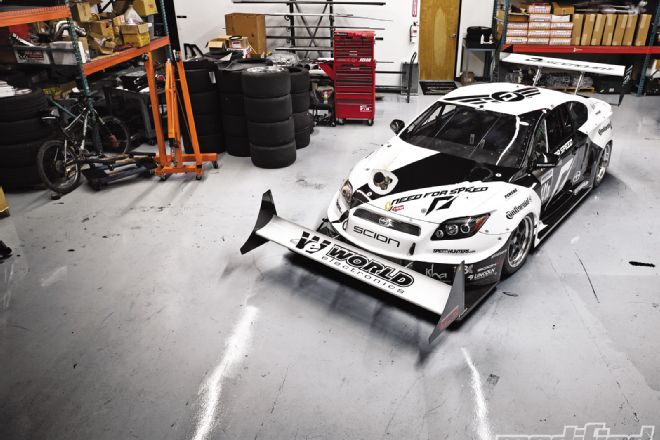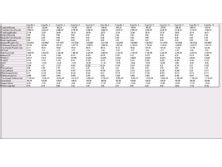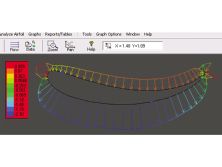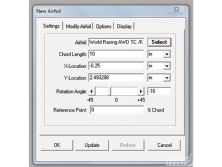If you picked up our Dec. '10 issue on the newsstand, chances are the awesome image of Chris Rado's fire-breathing WORLD Racing AWD Scion tC on the cover helped us earn your $5.99. The 4-foot-long flame thrown out the hood exhaust has to be one of the coolest visuals ever produced by a race car, but if you've been following the progress of WORLD Racing's time attack program, then you know it's their use of a low-mounted front wing that's been the source of the most forum chatter. We've also received a lot of emails about the aerodynamic package on Rado's new AWD beast featured in that issue, so to shed a little more light on the subject, we rang up our friend Mike Mishler at Kognition Design, the manufacturer of both the front and rear wings on Rado's newest toy.
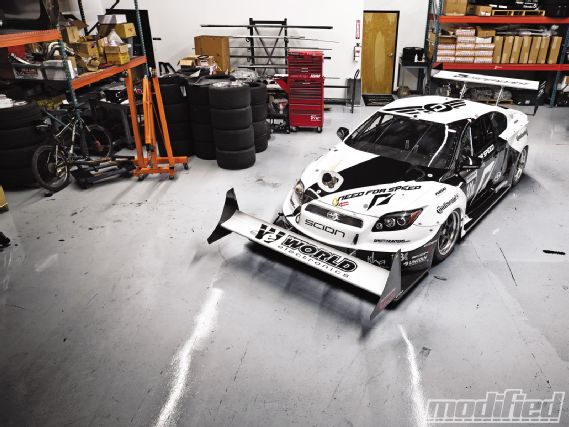 |
The controversial front wing on WORLD Racing's time attack Scion tC may seem completely insane, but the truth is a lot of science went into its sizing and positioning.
|
The controversial front wing on WORLD Racing's time attack Scion tC may seem completely insane, but the truth is a lot of science went into its sizing and positioning.
According to Mike, "I had been trying to work with Christian and his WORLD Racing team for the better part of a year before he asked me at Spring Mountain [during a time attack weekend] to get involved on the AWD project. I would carry my CFD charts with me all the time at the track, so I just whipped them out and showed him what was possible. We then began experimenting with aggressive wing profiles from Formula 1 that were in line with what his time attack team was aiming to achieve, meaning adding serious grip through aggressive aerodynamics. Having learned a lot from their FWD car, Chris and his team understood that going as large as possible on the wing was the logical choice given the amount of horsepower the AWD car produces. So we went with our biggest span wing, which is 78 inches, for both the front and rear wings - the front wing having a cord [or depth] of 10 inches and the rear wing a cord of 12 inches. The rear wing may be changing in the spring, though, if we determine that it cannot keep up with the front wing."
In terms of the positioning of the controversial front wing, that's something that aerodynamicist Barnaby Wainfan helped determine. According to Mike, "Barnaby comes from the aerospace sector with many years under his belt in the field of aerodynamics. We worked out the details of the front wing in terms of optimized spacing from the trailing edge to the front of the car in order to maximize the low-pressure field, as well as dialing in the height of the wing to optimize ground effect. The wing can stall if there isn't enough air flowing beneath it, and since it's so close to the ground and the front bodywork, we needed Barnaby's knowledge to sort that all out. Lowering the front wing on this car did involve some trade-off, though. With the lower position, we are getting more fulcrum leverage, which helps control the car's pitch in the turns and helps the tires work better, too, but we also get less true downforce when pulling it down out of the free air it was seeing on the FWD car. Hence the changeover to a more aggressive wing profile, which is working both as a wedge [or spoiler] and a wing [or airfoil] because of its location."
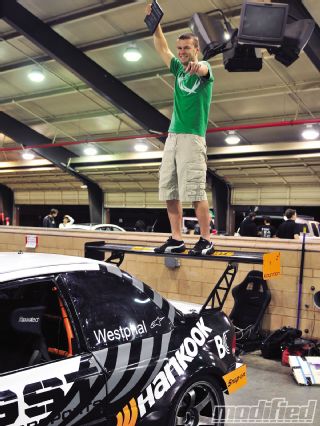 |
GStig posing on the rear wing of GST Motorsport's GC Impreza after a time attack win, a stunt that proves just how strong Kognition's wings and mounting hardware really are.
|
GStig posing on the rear wing of GST Motorsport's GC Impreza after a time attack win, a stunt that proves just how strong Kognition's wings and mounting hardware really are.
As the CFD (computational fluid dynamics) data Mike provided us with shows, the front wing on Rado's new AWD beast is making some serious downforce with surprisingly little drag and horsepower consumption, even at the lower position it's currently mounted at. At 100 mph and with the angle of attack in the middle of its range, the front wing is making 345 lbs of downforce with just 33 lbs of drag and 8.4 hp used. Max the angle of attack out and there's more than 400 lbs of downforce at 100 mph. When this front downforce is combined with the rest of the aerodynamics package on the WORLD Racing AWD Scion, Mike estimates the total downforce is currently in the ballpark of 1,500 lbs at 120 mph, and that number could go as high as 2,000 lbs once the package is fully sorted out.
With respect to analyzing CFD data like the snapshot we've shown you here (see above), the first place to look is, of course, downforce (or negative lift), drag and power used (or horsepower consumption), but there are other important variables to consider as well. As Mike pointed out to us, "Low drag is very important, but if you have more than, say, 500 horsepower, drag can be overcome. The idea is to not let your wing stall, which is the magic behind Formula 1 wings. Other important factors include elevation and air temperature. I can, for example, factor elevation into my simulations, which recently proved useful for a Swedish team running my wing on an Ultima GT-R that they plan to break the Nürburgring lap record with. We analyzed the effects of elevation change at the 'Ring and determined that their wing would lose 40 lbs of downforce between the lowest point on the track and the highest, allowing them to adjust their wing angle to best suit these changing conditions."
In terms of construction, Kognition's wings are literally strong enough to stand on (a fact GST Motorsports driver Jeff "GSTig" Westphal recently tested, as you can see). Part of the secret to Kognition's wing strength is, according to Mike, the specially woven carbon fiber they use. "We use the freshest carbon fiber, ordered 30 yards at a time so that they have the least amount of oxygen exposure, which over time causes brittleness. We use two different carbon cloth weave styles combined in one wing. The first is a 24K plain weave, aerospace grade, with a tensile strength of 600K pounds psi. It is heavy at 20 ounces per square yard and is the workhorse fabric in the wing. The second is a 12K twill weave, also aerospace grade, with the same strength and weight as the 24K. Both fabrics are several millimeters thick in dry state, but after vacuum infusion the wing shell is only 1.5mm, so it's highly compacted. Our actual production process of the wing shells is proprietary, so I can't discuss it in too much detail, but we currently produce two wing shells per day. And those are in the form of 80-inch stock blanks. We then take orders based on the model the customer requests, or custom span they request. Our hardware is CAD rendered in-house and then emailed down the street to our local water-jet shop and then shipped over to our anodize shop. Our internal ribs are also water-jetted, as are our endplates and endcaps."
Kognition Design may be a relative newcomer to the world of aerodynamics and wing manufacturing, but Mike Mishler has proven in just a few short years that his wings are up to the challenge of being mounted on some of the most extreme race cars in the world. Clearly, other top time attack teams are taking notice of WORLD Racing's wing choice; FXMD recently hired Kognition's wing making services for its awesome and ever-evolving Cricket NSX, which just reset the Super Lap Battle record at Buttonwillow for RWD cars and narrowly missed the overall record reset by Sierra Sierra Enterprises.

